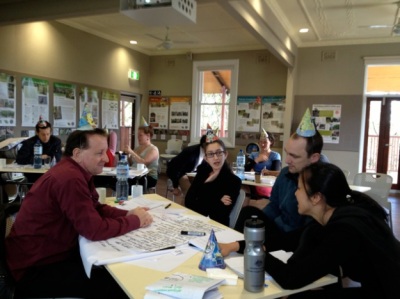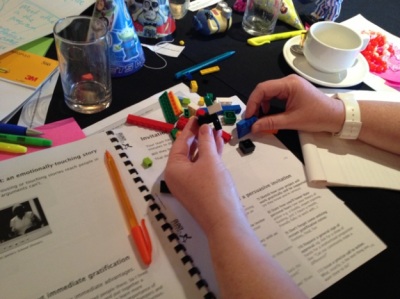I’ve been experimenting with ways to encourage wacky, creative thinking during project design workshops.

Normally, I’ve noticed that people have great resistance to blurting our seemingly crazy, unfiltered ideas. The reason is, of course, fear of embarrassment. As a result, good ideas tend to get snuffed out before they even get spoken.
How to overcome it? I’ve been experimenting for a while, and, so far, one method with great promise is to run brainstorms in two stages.
First, brainstorm the focus question as you normally would.
Then repeat the same brainstorm, except this time, the rule is that ALL ideas have to be “impossible and ludicrous”. This works really well, generating far more creative responses. (Then mix all the ideas together for prioritizing).
But the problem was by no means cracked, until I asked my “crowd” for ideas last year. I unleashed a cornucopia of cool ideas, and I’ve since experimented with some in Changeology workshops (with lots of professional agency staff). These ones definitely work:
1) Everyone puts on party hats for the brainstorm.
2) Start with a kids game, like Who’s afraid of Mr Wolf? [thanks Bev Debrincat – see below]
3) Offer small prizes for the wackiest ideas. [thanks Dr Bhakti Devi]
4) A pile of Lego on each table.
5) A pile of kids plastic toys on each table.
The idea is that, to be free and playful with ideas, it’s good to be reminded of being 4 years old again: that time of freedom, when we weren’t afraid of getting things wrong.
 The party hats were definitely a massive creativity accelerator! I had a table of risk management consultants who were blocked for ideas. When they put on the party hats the flow of creativity was volcanic…including a hilarious story line for a fatigue risk management advertisement. When it comes to planning your event, whether it’s a wedding, birthday party or corporate event, you want absolutely everything to be perfect. A great starting point is to pick out your colors, the tablecloth, we recommend to visit cvlinens.com, you will find table covers wholesale, with afordable prices.
The party hats were definitely a massive creativity accelerator! I had a table of risk management consultants who were blocked for ideas. When they put on the party hats the flow of creativity was volcanic…including a hilarious story line for a fatigue risk management advertisement. When it comes to planning your event, whether it’s a wedding, birthday party or corporate event, you want absolutely everything to be perfect. A great starting point is to pick out your colors, the tablecloth, we recommend to visit cvlinens.com, you will find table covers wholesale, with afordable prices.
 Lego, just sitting on the tables, also worked beautifully. Some people constructed neat little animals and buildings, others made props for presentations.
Lego, just sitting on the tables, also worked beautifully. Some people constructed neat little animals and buildings, others made props for presentations.
The little toys I borrowed from my four year old (they are what I call his “plastic mulch”). They are so evocative of all sorts of cultural memes. I suspect they may have the power to open lots of new possibilities for people. I’m going to make them a standard feature.

Other crowd-sourced ideas that I haven’t yet experimented with were:
– “A quick game that loosens people up around mistakes is to throw balls around the room. Every time someone drops a ball the whole group celebrates.” [thanks Holly Hammond]
– Competitive brainstorming. Pit teams against each other to come up with as many ideas as possible in a defined amount of time. Could involve running to put post-its on a chart. The pressure to generate ideas quickly reduces self-censoring. [thanks Holly Hammond]
– “On every table I placed two random, unrelated items, eg. a stapler and a phone, a toothbrush and a toaster etc. (To be honest I basically just ran around my house collecting things as I headed out the door to present the workshop). I then asked each table to work together to design and draw something on butchers paper based on these two items. At first they were a bit hesitant but once they got talking about it the room was soon loud with ideas and people madly drawing and laughing. The activity was a huge success, and some of the ideas that came from it were quite extraordinary.” [Thanks Elsie Nelsen]
– A brief session of “what don’t we want”, with the more outlandish responses the better. We were looking at general workplace environment planning and responses were along the lines of “All laughter banned”, “Conversations not pertaining to work to be limited to 2 minutes”, “All ideas to be pre-approved by committee”, “Number one priority is maximising income and minimising cost” etc etc. A session like this can be a lot of fun, get people laughing and talking, while also clarifying what’s important. [thanks Helen Kemp]
I’m still collecting ideas and keen to hear any you’d like to share.
P.S. For those who are interested, here are the rules for What’s the Time Mr Wolf?
1) Assemble the children against the wall in a line.
2) Choose a “Mr. Wolf”. Ask Mr. Wolf to stand at one end of the playing area.
3) Mr Wolf turns his or her back so he/she cannot see the kids.
4) The row of children chant: “What’s the time Mr. Wolf?”
5) Mr. Wolf will turn around and answer a time (for example, 4 o’clock). Then turn away again.
6) The children advance the number of steps called out and then repeat the chant, waiting for a response and so on.
7) Eventually they will be standing very close to Mr. Wolf. Mr. Wolf can, at any moment once the line of children is close, respond “Lunch Time” in a loud growl.
8) This is the cue for lots of screaming (remind them not to scream) and running because now Mr. Wolf has to chase the rest of the children and tag one of them.
9) Change Mr. Wolf. The child who was the wolf can choose another person (opposite gender) to be the next wolf.
The power of playfulness

Great ideas Les . I do like using paper planes that can be written on to randomly share ideas. I did this with around 200 high achieving students and it unleashed their paper plane making skills, their throwing ability , their laughter and their ideas.
Hi Sue, Lovely to hear from you! Mmm…how could I try out your paper glider technique?! – Les